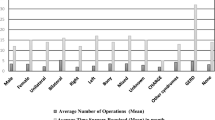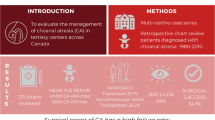Abstract
Purpose
To evaluate the outcome of a routine postoperative endoscopic micro-debridement of granulation tissue after stentless transnasal endoscopic repair of choanal atresia (CA).
Methods
This prospective case series included congenital CA patients who underwent stentless transnasal endoscopic repair, followed by an endoscopic second look and micro-debridement of granulation tissue at 1–2 weeks post-repair. Patients were followed every three months for assessment of nasal airway symptoms and objective evaluation by flexible nasolaryngoscopy.
Results
Sixteen CA patients (8 bilateral and 8 unilateral) underwent surgical repair (12 primary and 4 revisions). The median age was 13 days (range 1 day–6 months) in bilateral and 3 years (range 7 months–15 years) in unilateral atresia. The mean follow-up was 1.5 years (range 1 year–3 years). In primary procedures, the obstruction was bony-membranous in 7 cases and bony in 5 cases. The mean interval time between the CA repair and re-examination was 10.75 days (range 6–18 days). Clinically significant neochoanal restenosis was not encountered.
Conclusions
Re-examination under general anesthesia with endoscopic micro-debridement of granulation tissue is a safe, potentially effective adjunct when done during the proliferative phase of neochoanal wound healing. This procedure might help in maintaining neochoanal patency by remodeling tissue healing process. Large-scale, long-term cohort studies are imperative.


Similar content being viewed by others
Data availability
Not applicable.
References
Hengerer AS, Brickman TM, Jeyakumar A (2008) Choanal atresia: embryologic analysis and evolution of treatment, a 30-year experience. Laryngoscope 118:862–866. https://doi.org/10.1097/MLG.0B013E3181639B91
Ferlito S, Maniaci A, Dragonetti AG et al (2022) Endoscopic endonasal repair of congenital choanal atresia: predictive factors of surgical stability and healing outcomes. Int J Environ Res Public Health. https://doi.org/10.3390/ijerph19159084
Urbančič J, Vozel D, Battelino S et al (2023) Management of choanal atresia: national recommendations with a comprehensive literature review. Children. https://doi.org/10.3390/children10010091
Ledderose GJ, Havel M, Ledderose C, Betz CS (2021) Endoscopic endonasal repair of complete bilateral choanal atresia in neonates. Eur J Pediatr 180:2245–2251. https://doi.org/10.1007/S00431-021-04020-3/METRICS
Durmaz A, Tosun F, Yildirim N et al (2008) Transnasal endoscopic repair of choanal atresia: results of 13 cases and meta-analysis. J Craniofac Surg 19:1270–1274. https://doi.org/10.1097/SCS.0B013E3181843564
Rajan R, Tunkel DE (2018) Choanal atresia and other neonatal nasal anomalies. Clin Perinatol 45:751–767. https://doi.org/10.1016/J.CLP.2018.07.011
Moreddu E, Rizzi M, Adil E et al (2019) International Pediatric Otolaryngology Group (IPOG) consensus recommendations: diagnosis, pre-operative, operative and post-operative pediatric choanal atresia care. Int J Pediatr Otorhinolaryngol 123:151–155. https://doi.org/10.1016/j.ijporl.2019.05.010
Uzomefuna V, Glynn F, Al-Omari B et al (2012) Transnasal endoscopic repair of choanal atresia in a tertiary care centre: a review of outcomes. Int J Pediatr Otorhinolaryngol 76:613–617
Eladl HM, Khafagy YW (2016) Endoscopic bilateral congenital choanal atresia repair of 112 cases, evolving concept and technical experience. Int J Pediatr Otorhinolaryngol 85:40–45. https://doi.org/10.1016/j.ijporl.2016.03.011
Bartel R, Levorato M, Adroher M et al (2021) Performance of endoscopic repair with endonasal flaps for congenital choanal atresia. A systematic review. Acta Otorrinolaringol Esp 72:51–56
Samadi DS, Shah UK, Handler SD (2003) Choanal atresia: a twenty-year review of medical comorbidities and surgical outcomes. Laryngoscope 113:254–258. https://doi.org/10.1097/00005537-200302000-00011
Murray S, Luo L, Quimby A et al (2019) Immediate versus delayed surgery in congenital choanal atresia: a systematic review. Int J Pediatr Otorhinolaryngol 119:47–53. https://doi.org/10.1016/j.ijporl.2019.01.001
Strychowsky JE, Kawai K, Moritz E et al (2016) To stent or not to stent? A meta-analysis of endonasal congenital bilateral choanal atresia repair. Laryngoscope 126:218–227. https://doi.org/10.1002/lary.25393
Ramsden JD, Campisi P, Forte V (2009) Choanal atresia and choanal stenosis. Otolaryngol Clin N Am 42:339–352. https://doi.org/10.1016/J.OTC.2009.01.001
Wormald PJ, Zhao YC, Valdes CJ et al (2016) The endoscopic transseptal approach for choanal atresia repair. Int Forum Allergy Rhinol 6:654–660. https://doi.org/10.1002/alr.21716
Tomoum MO, Askar MH, Mandour MF et al (2018) Stentless mirrored L-shaped septonasal flap versus stented flapless technique for endoscopic endonasal repair of bilateral congenital choanal atresia: a prospective randomised controlled study. J Laryngol Otol 132:329–335. https://doi.org/10.1017/S0022215117002614
Cedin AC, Fujita R, Cruz OLM (2006) Endoscopic transeptal surgery for choanal atresia with a stentless folded-over-flap technique. Otolaryngol Head Neck Surg 135:693–698. https://doi.org/10.1016/j.otohns.2006.05.009
Funding
This research did not receive any specific grant from funding agencies in the public, commercial, or not-for-profit sectors.
Author information
Authors and Affiliations
Contributions
All authors contributed to the study conception. Procedure, data collection, and interpretation were performed by AA. The first draft of the manuscript was written by DA and all authors commented on previous versions of the manuscript. All authors read and approved the final manuscript.
Corresponding author
Ethics declarations
Conflict of interest
The authors have no competing interests to declare that are relevant to the content of this article.
Ethics approval
Approval was obtained from the ethics committee of Imam Abdulrahman Bin Faisal University, Dammam, Saudi Arabia. The procedures used in this study adhere to the tenets of the Declaration of Helsinki.
Consent to participate
Written informed consent was obtained from the parents.
Additional information
Publisher's Note
Springer Nature remains neutral with regard to jurisdictional claims in published maps and institutional affiliations.
Supplementary Information
Below is the link to the electronic supplementary material.
Supplementary file1 Online Resource 1 Endoscopic bilateral choanal atresia repair for a 13-day-old girl illustrates the critical steps of the procedure. Step 1: identifying the boundaries of the atretic plate; Step 2: raising a laterally based mucosal flap bilaterally; Step 3: resecting the posterior septum and atretic plate; Step 4: resecting the nasopharyngeal mucosa of the atretic plate; Step 5: removal of the medially projected bone of the medial pterygoids; Step 6: repositioning the mucosal flaps to the cover the lateral exposed bones of the neochoana. (MP4 88223 KB)
Supplementary file2 Online Resource 2 Endoscopic second look and granulation tissue debridement of the noechoana at one week post-endoscopic repair of a 13-day-old girl with bilateral congenital choanal atresia. (MP4 17676 KB)
Rights and permissions
Springer Nature or its licensor (e.g. a society or other partner) holds exclusive rights to this article under a publishing agreement with the author(s) or other rightsholder(s); author self-archiving of the accepted manuscript version of this article is solely governed by the terms of such publishing agreement and applicable law.
About this article
Cite this article
AlKhateeb, A., Alrusayyis, D. Can a second look improve the outcome of endoscopic choanal atresia repair?. Eur Arch Otorhinolaryngol 281, 1331–1336 (2024). https://doi.org/10.1007/s00405-023-08323-z
Received:
Accepted:
Published:
Issue Date:
DOI: https://doi.org/10.1007/s00405-023-08323-z




